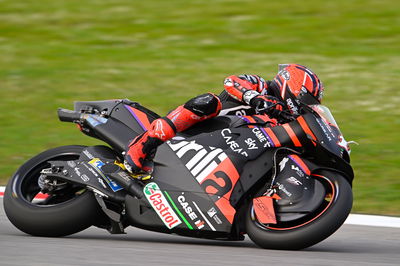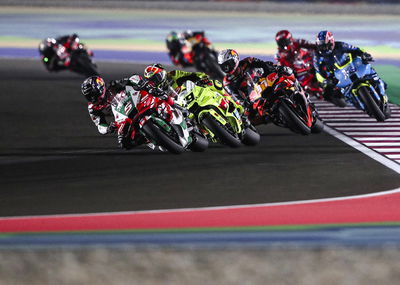MotoGP bikes ‘will feel different’ for Sprint vs Sunday races, ‘it’s complicated

45% less fuel is the most obvious bike change for the half-distance Saturday afternoon races.
A modified tank, to keep the smaller fuel load in an optimum position, plus suspension tweaks to suit the lower starting weight are also likely to be used.
But engine performance and traction control electronics can also be tuned more aggressively, with tyre endurance far less of a concern.
“There is a different configuration on the bike for one race and for the other one [on a 2023 weekend],” new GASGAS Tech3 rider Espargaro said of the Sprint vs Sunday set-up. “So about torque, spin [traction control], tyre management... It's so complicated.”
- Huewen: ‘Marquez will pull something out the bag, but Ducati streets ahead’
- Miller: Bagnaia ‘changed man', Alex Marquez 'impressive, happy for him'
- Marc Marquez: ‘We cannot think about the podium, fifth to tenth’
“The bike is going to feel different,” he added. “Just starting with half the weight of a full fuel tank, for sure, you're going to feel a big difference.”
Tyre choice is set to be another major variable, with most riders expected to use the softest rear option for the Sprint before switching to the harder compound for the Sunday race.
While preserving tyre performance is critical in a full-length race, even the soft rear tyres should be able to withstand abuse during the Sprints.
“You don't need to care about tyre management when there is only half of the race distance,” Espargaro said. “You can burn more of the tyre because the tyre efficiency is not going to drop so much."
In terms of fuel consumption, while 22 litres is allowed for the normal grand prix distance, 12 litres (rather than 11) are permitted for the 50% Sprint distance.
That extra litre means the thirstier/more powerful bikes will be able to run their engines at full performance for a longer proportion of the Sprint.
“We know that in this championship there are quite a lot of bikes that are quite strong when they don't care about the fuel [consumption],” Espargaro said, presumably hinting at the Ducatis.
“So also the torque delivery of many bikes is going to be on full [maximum] for the Sprint, while in many places with the long race, they will [lower] the torque level.
“Overall, it's going to change a lot.”
Not only will teams and riders now need to optimise their set-ups for a qualifying time attack, Sprint race distance and full race distance each weekend - they’ll need to do it with less practice time than before.
“I'm sure you will need to be more alert and efficient in working with the team," said Espargaro.
"The relationship between the technical part and the rider will be so important, to understand and improve upon the problems faster, with less [practice] time on the bike.
“You need to work very efficiently. I think everyone is going to adapt through the year, hopefully, we can adapt faster than the others!”
From his own perspective, Espargaro thinks less practice time could be better.
“I really like when you don't have so much time to work on the bike, because then the bike level is less important, let's say. With more time to work on the bike then every rider is reaching the limit of the bike,” he explained.
“It’s like in a test, when there are many guys very fast [by the end]. But if you put a session of just 1 hour then they struggle more. But we will see.”
Next weekend's Portimao season-opener will be Espargaro's first MotoGP event on a KTM RC16 since 2020.












